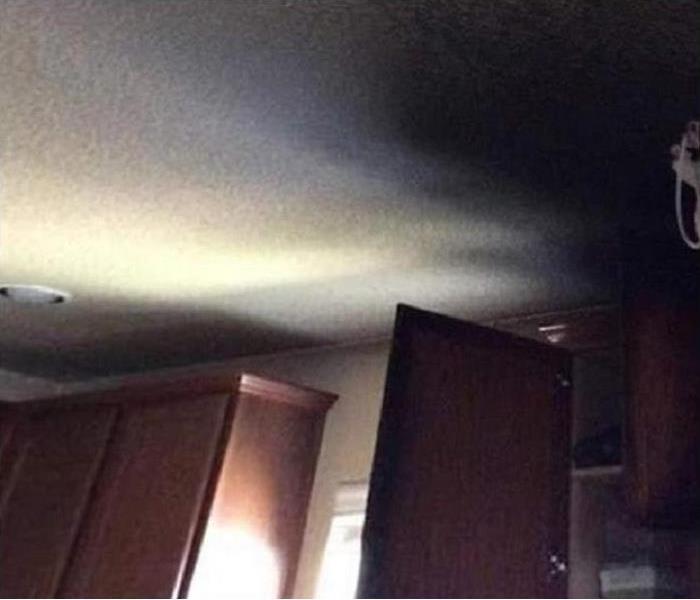How Can You Decide What Is Salvageable After a Shreveport House Fire?
4/24/2020 (Permalink)
 Fire damage spreads quickly throughout the home. SERVPRO is a complete fire damage restoration specialists.
Fire damage spreads quickly throughout the home. SERVPRO is a complete fire damage restoration specialists.
Enlist the Expertise of Your Local SERVPRO to Help Save Time, Expense, and Memories in Your Shreveport Home
Nothing about dealing with the devastation of a residential fire is easy. Once you have experienced the heat, flames, and destruction, you are likely to be on an emotional roller coaster like no other. You need a rapid assessment of the damage done to your Shreveport home’s structure, followed by immediate implementation of a recovery plan by a highly-trained and qualified team of experts.
Who Knows Which Items to Discard and Which to Save?
Although it might seem as though our managers and technicians are focused primarily on the fire damage to your Shreveport house’s structure, we also have comprehensive training and familiarity with the evaluation and appropriate restoration of compromised household goods and furnishings. We can also assist with any question you have about personal goods and possessions. Sometimes homeowners discard items they could have saved, wasting time and expense to replace. Rely on our trained professionals for expert evaluation and guidance when you wonder and worry about contents cleaning and recovery after fire damage.
Are Some Household and Personal Items Hazardous to Keep After a Fire?
Some categories of household contents can pose concerns if kept for use after Shreveport fires. Items for consumption or that are likely to be in close contact with your family must be evaluated carefully and discarded if no restoration can stop their damaged condition from putting your or your family’s health at risk.
Can You Keep Food After a Fire?
Even if the food looks normal and seems unburned by the flames, there can be many crucial reasons why our crew members recommend that disposal of it should occur.
Non-Perishable Food
- Food in opened packages or on counters or tables needs discarding. Smoke, soot, and firefighting chemicals or water contaminate the food, rendering it unfit or even dangerous for consumption.
- Food still sealed in bags, bottles, jars, and cans might seem safe, but if they had exposure to heat during the fire, the temperature change could activate bacteria inside containers. Food spoilage and poisoning can occur, demanding that you err on the side of caution and throw out any questionable food.
- Toxic fumes and even soot can pass through the cardboard and plastic of boxed foods like crackers, cereals, and baking supplies. Particles have been found in jars, climbing the ridges on a screw top. Throw out any foodstuff in this category.
Perishable Food
A refrigerator or freezer can provide adequate protection for the foods kept within during a fire under certain circumstances. As long as all the following is true, the contents are likely to be safe.
- The appliance sustained no fire or heat damage and remained sealed the entire time.
- Power not cut or four or fewer hours passed without electrical operation.
Regardless of a “passing grade” received by meeting the above criteria, if any of the following is accurate, do not eat frozen or chilled food:
- A smoke smell pervades the interior of the appliance
- Soot is visible inside the appliance
- The temperature of the interior of a refrigerator exceeds 40 degrees
- Items in a freezer are softening and have no visible ice crystals
- Foods have any unusual odor or texture
What Are the Rules About Using Medications, Cosmetics, and Other Personal Care Items After a Fire?
If heat or flames were near over the counter or prescription drugs or treatments, chemical changes could occur. Especially if bottles, jars, tubes, or packaging shows melting or warping, discard.
Anything used on the body, face, or hair also can undergo chemical changes through heat or burning, and soot can pass through packaging. Shampoos, lotions, creams, soaps, body washes, and other items are all of concern. Soot particles are toxic and abrasive, so even tissues, toilet paper, paper towels, napkins, and similar products like diapers, cotton balls or swabs, hair or face brushes, sponges, and more can be harmful to use on skin or hair.
Is It Safe to Reuse Linens and Clothing?
Restoration for textiles and fabrics is possible with proper cleaning, disinfection, and deodorization. SERVPRO technicians at our production facility can examine and review the fire damage to these items to make sure you and your family can enjoy them again safely.
What Are the Recommendations for Furniture, Household Goods, and Personal Possessions?
We often suggest a partial pack-out of a wide range of the removal of fire damaged items in your home. We use a detailed Contents Claim Inventory Service (CCIS) to track the articles, employing traditional lists, barcoding, and digital images. Our specially trained content technicians have a wide range of resources and interventions to assess and plan for the restoration of the items. The documentation provided by CCIS helps us keep your insurance carrier apprised and can support claims for our services or replacement when necessary.
Years of highly skilled and well-equipped responses to residential fire damage poises SERVPRO of South Shreveport to assist you and your family with taking care of all the aspects of fire loss devastation. Call us 24/7 at (318) 865-4655 for compassionate professional mitigation and remediation services for your home and its contents.






 24/7 Emergency Service
24/7 Emergency Service